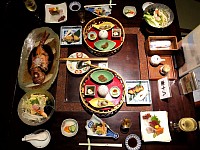Kaiseki: A Culinary Journey Through Japan’s Finest Dining
If there’s one dining experience in Japan that will make you feel like royalty, it’s kaiseki (懐石). Imagine a beautifully orchestrated multi-course meal where every dish tells a seasonal story, each bite is a work of art, and the service makes you feel like a VIP. Kaiseki isn’t just a fancy meal—it’s an experience, a tradition, and a deep dive into Japan’s love for precision and beauty in food.
And honestly, I need to try this. I’m moving to Japan in October and want to experience as much of the food culture as possible. Kaiseki seems like the perfect way to immerse myself in Japan’s culinary artistry—and maybe even make some friends to go with me! Or when my parents are helping me move in they can try it with me! The possibilities are endless!
What’s the Deal with Kaiseki?
Kaiseki is Japan’s version of haute cuisine, a meticulously crafted multi-course meal that celebrates the best of seasonal ingredients. It started humbly as a small meal during traditional tea ceremonies but evolved into an elaborate fine dining experience. Think of it as a culinary symphony—each course plays its part in a perfectly harmonized meal.
The goal? Balance. Every dish is thoughtfully designed to highlight different textures, temperatures, colors, and flavors. And yes, it’s as Instagram-worthy as it sounds!
The Kaiseki Philosophy: More Than Just Pretty Food
Kaiseki isn’t just about making food look and taste amazing (though it definitely does). It’s built on five key principles:
1. Seasonality (Shun - 旬) – Only the freshest, in-season ingredients make the cut.
2. Balance (Go-mi, Go-shoku, Go-ho - 五味五色五法) – A mix of five flavors (sweet, sour, salty, bitter, umami), five colors (red, yellow, green, black, white), and five cooking methods (raw, simmered, grilled, fried, steamed).
3. Presentation (Shitsurai - しつらい) – Every dish is a visual masterpiece, often inspired by nature.
4. Hospitality (Omotenashi - おもてなし) – This is next-level hospitality where the chef tailors the experience just for you.
5. Minimalism (Wabi-sabi - 侘寂) – Beauty in simplicity—every detail, from the plate to the garnish, has a purpose.
What’s on the Menu?
A kaiseki meal isn’t a free-for-all; it follows a specific flow. Here’s what you can expect:
- Sakizuke (先附) – A small appetizer, like a fancy amuse-bouche.
- Hassun (八寸) – A seasonal platter that sets the theme for the meal.
- Mukozuke (向付) – Fresh sashimi that’s almost too pretty to eat (but you’ll eat it anyway).
- Takiawase (炊合せ) – Simmered veggies and proteins in a delicate broth.
- Futamono (蓋物) – A lidded dish, usually a soul-warming soup.
- Yakimono (焼物) – A grilled dish, often an expertly prepared fish or meat.
- Su-zakat (酢肴) – A palate-cleansing vinegar-based dish.
- Shiizakana (強肴) – A bolder, heartier dish like hotpot or tempura.
- Gohan, Miso Soup, and Tsukemono (御飯・味噌汁・漬物) – The essentials: rice, miso soup, and pickles.
- Mizumono (水物) – A seasonal dessert because no meal is complete without a sweet treat.
Where to Experience Kaiseki in Japan
Now that you’re drooling, let’s talk about where you can experience this edible masterpiece:
Kyoto – The OG Kaiseki Destination
Kyoto is the birthplace of kaiseki and home to some of the best spots:
- Kikunoi (菊乃井) – Michelin-starred perfection with a side of Kyoto charm.
- Hyotei (瓢亭) – A 400-year-old restaurant where tradition reigns supreme.
Ryokan Kaiseki – Food + Hot Springs = Perfection
Some of the best kaiseki meals include an overnight stay at a traditional Japanese inn (ryokan). If you want the ultimate experience, check out:
- Gora Kadan (Hakone) – A luxurious kaiseki and onsen relaxation blend.
- Hoshinoya Kyoto – Dine on a riverside while soaking in the scenery.
- Takaragawa Onsen (Gunma) – Kaiseki + a dip in a dreamy mountain onsen? Yes, please.
Final Thoughts: Is Kaiseki Worth It?
Absolutely! Kaiseki isn’t just a meal—it’s a once-in-a-lifetime experience that gives you a deep appreciation for Japanese culture, flavors, and culinary artistry. I seriously can’t wait to try it when I move to Japan. Maybe I’ll even find new friends to accompany me and make it an unforgettable night!
Have you ever had a kaiseki meal? If so, what was your favorite dish? Please comment below—I’d love to hear about your experience!

